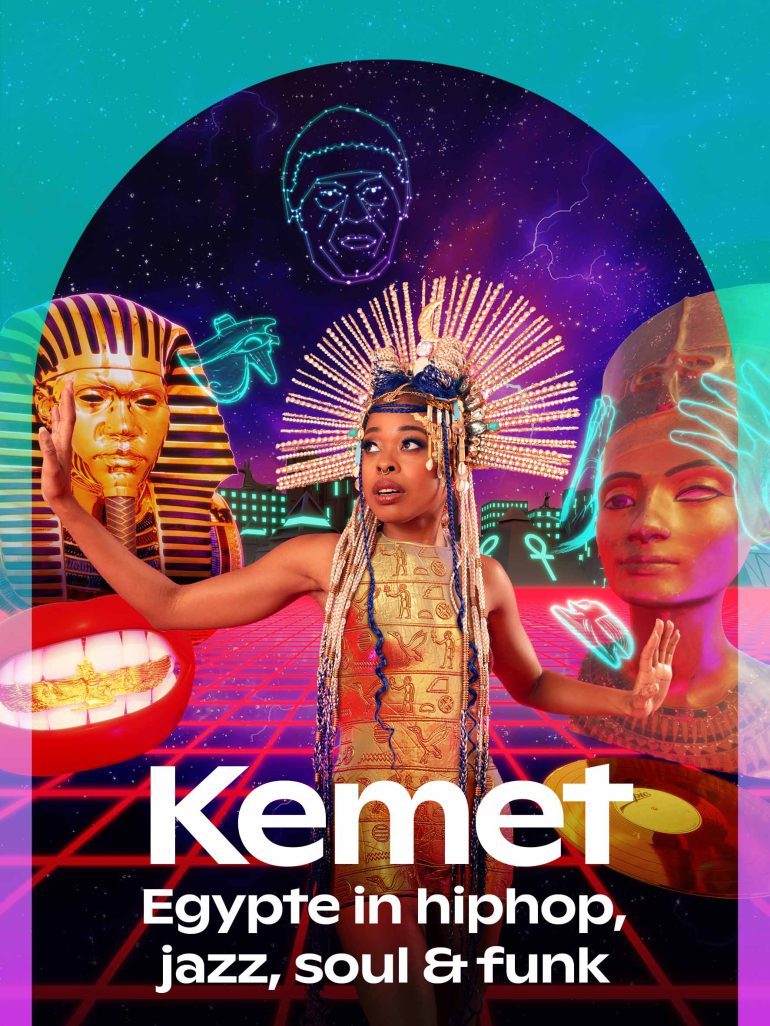The influence of ancient Egypt and Nubia is evident in the works of a multitude of musicians of African descent, including icons of jazz such as Miles Davis and Sun Ra and contemporary artists such as Beyoncé and Rihanna. To understand these imaginaries of ancient Egypt, created by these artists, the exhibition Kemet: Egypt in hip-hop, jazz, soul & funk in the National Museum of Antiquities (RMO) embarks on a journey through music history.
From Sun Ra to Rihanna
Beyoncé and Rihanna have both appeared on stage or in music videos as the Egyptian queen Nefertiti, and the cover art for Nas’ legendary album I Am depicts him as the Egyptian pharaoh Tutankhamun. In the 1990s, actor Eddie Murphy appeared as Pharaoh Ramses II in the music video for Michael Jackson’s Remember the Time, while virtually every Earth, Wind & Fire album cover featured an Egyptian motif or symbol. In the subsequent decade, artists like Lauryn Hill and KRS-One went on to rap about ancient Egyptian civilization. This ongoing phenomenon can be traced back to the 1950s, when jazz icon Sun Ra and his Arkestra began combining jazz, Egyptian themes and Afrofuturism into a style of music that evoked the space age and continues to resonate with audiences everywhere.
Kemet
Ancient Egypt and Nubia have been an undeniable source of inspiration for musicians of African descent for over 70 years, with artists not only embracing and claiming these ancient African cultures, but also employing the associated motifs as symbols of resistance, empowerment and spiritual healing. Such motifs include the name the Egyptians themselves gave their country: Kemet, ‘the black’, a reference to the fertile land along the Nile. The resulting expressions of Kemet present ancient Egyptian culture not only as historically important events and artifacts, but also as a means to discuss the present and the future. We see this in the music, lyrics and imagery employed by jazz, funk, soul, pop, reggae and rap artists over the last few decades, including Miles Davis, Nina Simone, Prince, Fela Kuti and Erykah Badu, as well as Dutch artists such as Zwart Licht and Ray Fuego.
Music and ancient artefacts
Music takes centre stage in the exhibition, its central theme brought to life with the aid of music videos, audio clips, concert recordings, photographs and album covers by musicians with a connection to ancient Egypt. The accompanying audio tour is by Dutch hip-hop artist Typhoon, and a new single by Nnelg explains the rap artist’s relationship with ancient Egypt and Nubia. Exhibition highlights include Nas’ gold mask of King Tutankhamun and several of Sun Ra’s Egyptian-inspired costumes. In addition, the exhibition explores the actual artefacts of ancient Egypt. The ancient cultures of Egypt and Nubia arose on the banks of the Nile around 5,000 years ago. These were rich and complex societies; the technological achievements of these civilizations included large temples for the worship of the many gods of the Egyptian religion, as well as the famous pyramids. The exhibition highlights a selection of items from the museum collections, including sculptures and figurines of Egyptian deities, gold jewellery, hieroglyphic texts and royal portraits.
Egypt as part of Africa
In Egyptology, the academic discipline that specialises in the study of ancient Egypt, Egypt has typically been treated as part of the Mediterranean region. But many artists of African descent are keen to stress the recognition of ancient Egypt as an African culture. Through their music, lyrics and visual representations, they convey their connection to the millennia-long history of the region, and claim this history as part of their past, present and future identity.
The exhibition will run Until 3 September. Complementing the exhibition is a full programme of music and events related to ancient Egyptian culture, which allows visitors to immerse themselves in the sights and sounds of music and ancient history.
More information:
